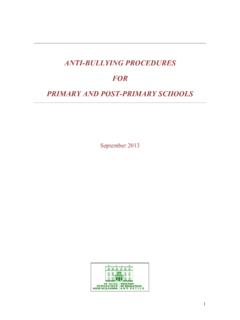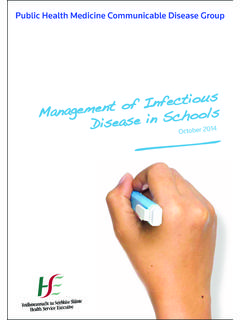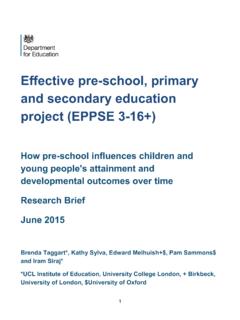Transcription of A Framework for the Junior Cycle - education.ie
1 Framework for Junior Cycle 2015. DEPARTMENT OF education AND SKILLS. Framework for Junior Cycle 2015. 2015 Department of education and Skills Published by Department of education and Skills Marlborough Street Dublin 1. This publication may be accessed at 1. Foreword from the Minister I am pleased to publish this document, the Framework for Junior Cycle (2015). It sets out a clear vision of how teaching, learning and assessment practices will evolve in the first three years of post-primary education to ensure a learning experience for our young people that is appropriate to the needs of the 21st century. This vision builds on the thinking underpinning the Framework for Junior Cycle (2012) and has been informed by engagement with the educational partners and by national and international research.
2 It also builds on effective practices in curriculum and assessment that are implemented by teachers in schools throughout the country. I believe that the Framework for Junior Cycle (2015) provides a valuable blueprint for guiding developments in Junior Cycle provision in the coming years. It places the student at the centre of the learning process and envisages a modernised curriculum across all subjects. It allows for new ways of learning and a broader range of skills to be properly assessed. The dual approach to assessment provides a valuable opportunity to embed classroom based assessment and formative assessment for learning while recognising the role of external assessment. The new reporting arrangements outlined in the Framework for Junior Cycle (2015) will also help to ensure that both parents and students get a broader picture of a student's learning progress and achievement throughout the whole of Junior Cycle .
3 Most importantly, the focus on teacher student feedback and professional collaboration envisaged between teachers has huge potential to enrich both the quality of students' learning and teachers' own professional engagement. The implementation of the Framework for Junior Cycle (2015) will require the commitment of all those involved in education , particularly school leaders and teachers. I, too, am committed to ensuring that the Junior Cycle is well supported and resourced and that the continuing professional development for school leaders and teachers will be of a very high quality. Steps are already being taken to ensure that the necessary professional time and resources are available to implement the new Junior Cycle successfully, particularly the elements relating to school based assessment.
4 I look forward to progressing the implementation of the Framework for Junior Cycle (2015) in collaboration with teachers and school management and of course with parents and students. Jan O Sullivan, TD, Minister for education and Skills 2. 3. Table of contents Chapter 1 Introduction .. 6. Chapter 2 How does the Framework Support Learning?.. 10. Principles .. 11. Statements of learning .. 12. Eight key skills .. 13. How does the Framework relate to other initiatives? .. 14. Chapter 3 What will students learn? .. 16. Subjects .. 17. Short 21. Wellbeing .. 22. Level 2 Learning Programmes and Priority Learning Units (PLUs) .. 23. Other learning experiences .. 25. 25. What are the implications of the Framework for existing Circulars and the Rules and Programme for Secondary Schools?
5 26. Diversity and accessibility .. 26. Chapter 4 How will teaching and learning change and what supports will be available?.. 28. Teaching and learning .. 29. How will teachers be supported in the changes in practice? .. 30. How will school leaders be supported? .. 31. What additional resources will be made available to schools? .. 31. Chapter 5 What will assessment look like? .. 34. Approaches to assessment .. 35. Formative and summative assessment .. 35. Assessment and subjects .. 37. Assessment and short courses .. 41. Assessment and Wellbeing .. 42. 4. Assessing and reporting on students' learning in Priority Learning Units (PLUs) .. 42. Chapter 6 What will reporting look like? .. 44. Reporting to parents/guardians on students' progress over the course of Junior Cycle .
6 45. The Junior Cycle Profile of Achievement (JCPA) .. 46. How will the quality of student achievement be assured?.. 48. Chapter 7 Summary .. 50. Appendix Statements of Learning- Explanation of Learning Experiences .. 51. Tables Table 1 Twenty-four statements of learning .. 12. Table 2 Phased Implementation of Junior Cycle .. 17. Table 3 Subjects available for 18. Table 4 Specification for subjects .. 19. Table of Figures Figure 1 Eight Framework for Junior Cycle principles .11. Figure 2 Key skills and their 13. Figure 3 Planning for learning, teaching and 36. Figure 4 The interlinked nature of learning and 41. Figure 5 Learning opportunities and elements for reporting .. 44. 5. Chapter 1. Introduction This document, the Framework for Junior Cycle (2015), outlines the key educational changes that the Department of education and Skills (DES) is putting in place for young people in the first three years of their post-primary education .
7 It builds on and advances the vision for Junior Cycle reform that was outlined in the Framework for Junior Cycle (2012). The Framework for Junior Cycle (2015) incorporates a shared understanding of how teaching, learning and assessment practices should evolve to support the delivery of a quality, inclusive and relevant education that will meet the needs of Junior Cycle students, both now and in the future. This shared understanding is informed by engagement with stakeholders and by national and international research. This introductory section provides an overview of the key aspects of change relating to the delivery of Junior Cycle provision as envisaged in the Framework for Junior Cycle (2015). 6. A flexible programme for students' learning The Framework for Junior Cycle (2015) gives schools greater flexibility to design programmes that are suited to the needs of their Junior Cycle students and to the particular context of the school.
8 Each school's programme: will be guided by the twenty-four statements of learning, eight principles and eight key skills that are at the core of the new Junior Cycle will encompass learning in subjects or a combination of subjects and short courses will include an area of learning entitled Wellbeing will provide a range of other learning experiences may include priority learning units (PLUs) that will help to provide a Junior Cycle programme that is appropriate to the needs of particular students with significant special educational needs. Schools will have the flexibility and discretion to decide what combination of subjects, short courses or other learning experiences will be provided in their three-year Junior Cycle programme. Balance between knowledge and skills The Framework for Junior Cycle (2015) outlines the curriculum and assessment arrangements that will provide students with learning opportunities that achieve a balance between learning subject knowledge and developing a wide range of skills and thinking abilities.
9 These curriculum and assessment arrangements will promote a focus on active and collaborative learning. In particular, learners will be enabled to use and analyse information in new and creative ways, to investigate issues, to explore, to think for themselves, to be creative in solving problems and to apply their learning to new challenges and situations. Given the changing nature of knowledge, the ease with which students have access to information, and the pace of change in the workplace and the world generally, these competences and skills are critical to the preparation of young people for learning and living. Subject specifications, heretofore known as syllabuses, and assessment arrangements will be revised on a phased basis to reflect this new balance between subject knowledge and skills.
10 These new subject specifications are being designed to build on current best practices in the system and to support the further development of effective teaching, learning and assessment practice. The inclusion of short courses and other learning experiences in Junior Cycle programmes also provides a valuable opportunity to broaden students' learning and skill set. Dual approach to assessment The Framework for Junior Cycle (2015) presents a dual approach to assessment that supports student learning over the three years of Junior Cycle and also measures achievement at the end of those three years. This dual approach reduces the focus on one externally assessed examination as a means of assessing students and increases the prominence given to classroom-based assessment and formative assessment.










